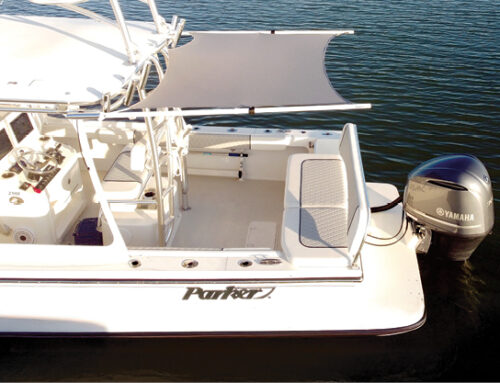Leading a company by building a strong culture for employee success

This project, which won a 2015 MFA Award of Excellence, was a custom-fit challenge; every curve and surface had to be patterned so the cover would form to the boat for traveling. The windshield mirrors made sliding on the cover a challenge. Ritsema solved the problem with relief cuts and Velcro® flaps. To prevent the cover from ballooning while traveling, he added multiple sewn-in vents to help release air.
Chris Ritsema leads his company, Canvas Innovations, by building a strong culture for employee success.
My vision has always been to grow a company that empowers its employees,” says Chris Ritsema, owner of Canvas Innovations in Holland, Mich. “I want to give people a reason to stay here and build their careers—and to do that we need to create a positive workplace culture with strong relationships.”
Ritsema began his career in marine fabrication directly out of high school. Aware that he was interested in working in a trade industry, Ritsema’s high school guidance counselor connected him with a local company that needed someone to fabricate boat enclosures and marine upholstery. “I had no experience—completely zero, which was kind of cool because it allowed them to train me from the ground up,” he says. “Now that’s how I look for people as well. I prefer people with no experience because otherwise I’d have to retrain them.”
The owners sold the business 18 years later, and Ritsema ventured into a marine fabrication partnership. Approximately 5 years after that he launched his own company. “I started Canvas Innovations with a 1,500-square-foot warehouse, no equipment and one employee—but what I did have going for me was fabrication experience and relationships with vendors,” he says. “Now, 6 years later I have 8 employees, a 5,800-square-foot warehouse—and we are bursting at the seams.”
Personality plus
Ritsema splits his time between the hands-on details of running a business and building a foundation for the company’s future. To that end, he’s been working with a business coach for the past two and a half years—which, he points out, is an important component of the company’s growth. “I focus heavily on relationships and finding ways to empower people to be better leaders,” he says. “I hired a business coach who has the same focus—someone who, among other things, can help us understand how our personalities relate to the way we operate within the company.”
The coach introduced Ritsema to Management By Strengths (MBS), a program designed to help companies increase productivity, customer satisfaction and employee morale. The program identifies four temperament traits identified by color: red signifies directness, with a focus on results; green is for extroversion, with a people-oriented focus; blue represents pace, meaning steady and easygoing; and yellow stands for structure, with a focus on doing what is right.
Ritsema—who identifies himself as “blue”—meets with the coach weekly, and his employees have met with the coach half a dozen times in the last year and a half. “We’ve all identified our colors,” he says. “When you’re working closely with people every day it’s important to understand how to approach each other and work together based on each person’s strengths. Part of how being ‘blue’ plays out for me is that I’m very factual. Everything needs to make sense on paper for me and if it does, I’ll get there.”

Another MFA Award of Excellence winner (2016), Ritsema’s company made and installed a full enclosure on an inflatable dinghy that presented challenging support and storage requirements.
Plotting a course for technology
Among the goals Ritsema has for Canvas Innovations is a move toward technology and automation—one he’s watched both small and large marine fabrication companies take in recent years. “I saw the plotter cutter technology eight years ago at [fellow MFA member] Mike Erickson’s shop [Canvas Designers, Riviera Beach, Fla.],” he says. “He and I have a similar background and I recognized that I wanted to grow a business like he has, but I wasn’t in a position to make it happen at that time—but I knew it was just a timing thing.”
Timing is one of Ritsema’s strengths, he says. He knows where he wants to go and how to plot a course to get there. Much like the way he works to bring his employees’ strengths together, Ritsema merges several of his long-term goals to move the company in the direction he wants it to go. When he is able to empower employees, help them with their long-term career goals and grow the business, he’s found the sweet spot.
To work toward bringing automation into his shop, Ritsema reached out to Mitch Lemmen, an employee who’s in his fifth year at the company. “I sat down with Mitch and asked what he thought about his long-term future—because, I said, if you want to make a career here, I want to start talking to you about future opportunities,” Ritsema says. “Because his strengths lean toward technology, I gave him the opportunity to lead this plotter cutter initiative.”
Ritsema garnered the help of another MFA member, Darren Arthur, owner of Nautilux Custom Canvas LLC in Hazlet, N.J. Last year, Ritsema took Lemmen to Arthur’s shop to learn more firsthand about what it takes to run a plotter cutter, including computer-aided design (CAD) skills. “I think Darren’s shop was one of the first small shops to use this technology,” Ritsema says. “We stayed and worked with him for four or five days in preparation to go down that road.”
After a considerable amount of teamwork, research and preparation, which included his first-ever trip to an IFAI Expo in 2016 to find out more about which plotter cutter would best suit his needs, Ritsema ordered the equipment and received it in January 2017.
For Ritsema, the financial investment required to buy the plotter cutter also includes investing in his employees’ continued education as opportunity arises and timing becomes appropriate. In January 2017 he took Lemmen to the MFA conference in Jacksonville, Fla., to help him further his knowledge about the industry as well as the new technology. “It’s so important to find the right people, find out if they have a love for the business and give them a future and a vision,” Ritsema says. “Mitch is committed to this as a career move.”
Ritsema has also brought other employees to MFA trade shows over the years. “My production manager Kenny Degroot has been to several events and has gained much towards the vision and future of Canvas Innovations,” Ritsema says. “Regional shows have become a better opportunity to take more than one employee along.”
Monthly give-and-take
Providing good wages and benefits is part of Ritsema’s strategy for encouraging employees to make a long-term commitment to the company, which depends to some degree on good communication and transparency. Last year Ritsema conducted a wage review within the industry to see how his pay scale compared to that of other shops and found that he pays at the high end of the scale. “I told my employees how we compared and gave them a vision for how they can earn the most money,” he says.
At the suggestion of his business coach, Ritsema also implemented the “Gap” system, which, in essence, is a monthly review system, in contrast to the traditional yearly performance review many companies use. “Why wait until the end of the year to tell your employees what they do well and what they need to improve on?” he says. “I’ve found that Gaps make people feel more appreciated and gives them a clearer path for how to move forward within the company.”
Ritsema boils down his approach to two things: putting people first and building culture. “If you don’t have a good culture, you can’t have a good team,” he says.
Sigrid Tornquist is a freelance writer and editor based in St. Paul, Minn.
 TEXTILES.ORG
TEXTILES.ORG 






